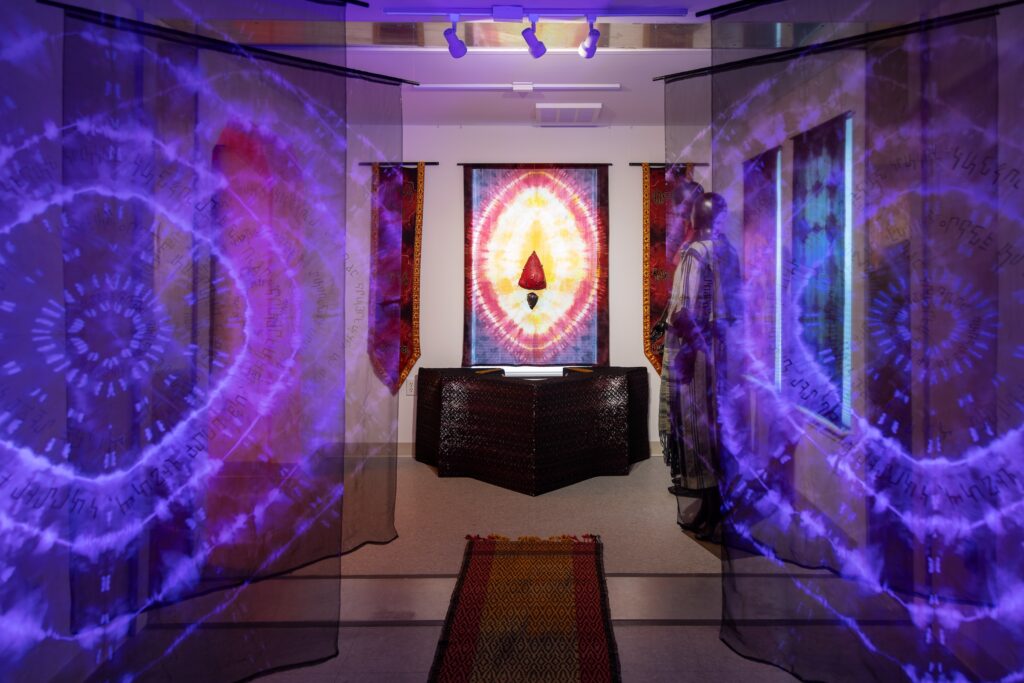[ad_1]
DETROIT — In Portal Fire: Shrines of the Torchbearer, Levon Kafafian invites visitors to embark on a transformative journey that transcends time and space, conjuring an imaginary world that challenges our perceptions of technology, memory, and identity. A hive of textile-based artistry centers speculative world-building as the artist traces a dynamic narrative that is rooted, both visually and linguistically, in Armenian tradition.
Kafafian, who works across a range of mediums, intricately threads their exhibition at the Museum of Contemporary Art Detroit with storytelling, taking visitors through a series of immersive vignettes that evoke the social fabric of a new world of the artist’s own making: Azadistan, taking its name from the Armenian word for freedom, azad. Kafafian transports us thousands of years into a future representing the ideals of resilience and pathways for cultural connection in the face of historical trauma and displacement.
The entrance hall, or the “antechamber,” is where we ritualistically cleanse and prepare ourselves for our pilgrimage to the sacred shine at the heart of Portal Fire. Further inside, we encounter the eternal flame at a ceremonial altar called the tonir — the Armenian word for a fire pit where bread is commonly baked along the sides, also symbolizing the sun. Kafafian transforms the second gallery into a shrine, in which San Francisco-based electronic musician and sound artist Lara Sarkissian has scored a fusion of Armenian spiritual and folk music that treads the line between memory and the unknown.

Two cloaks hand-woven from cotton, rayon, and metallic threads, titled Torchbearer Clerics (2024), stand guard at the shrine. Nearby, the set of silk-dyed panels comprising Torchbearer Cleric Auras (2024) details the rituals of the space with the history of the collapse of digital society in a futuristic language, which Kafafian created based on the endangered language of Western Armenian. Through English-language wall text, the artist translates the story of Azadistan. This approach prioritizes the viewer’s own experience in the space over Kafafian’s narrative, allowing us to absorb the world before we learn about it. The richly textured chamber enables a multilayered encounter that channels the realities of displacement and expansion in light of the historical and ongoing genocide of the Armenian people, including the extermination of tangible heritage, traditions, and lands.
By exploring these questions through textiles and language, Kafafian also visualizes the fabric of record-keeping, mediums of cultural connection, and affirmations of identity. In a world devoid of digital devices, textiles become prophecies and socio-political tools that challenge our construction of history — encouraging us to also think critically about our own beliefs and sketching an alternate vision of communication and expression beyond technological frameworks.
Eventually, we arrive at the most sacred artifact of Azadistan: the “Enshrined Relic of the Torchbearer.” According to the wall text, this mysterious relic has hovered in place for over 500 years, an artifact from a future that has yet to be born. It reminds us of how time and memory intertwine, and how our past can help us weave new futures — leaving a lasting impression that lingers long after you depart from the world of Azadistan.




Portal Fire: Shrine of the Torchbearer continues at the Museum of Contemporary Art Detroit (4454 Woodward Avenue, Detroit, Michigan) through February 23. The exhibition was organized by the museum with the International Studio & Curatorial Program.
[ad_2]
Source link

